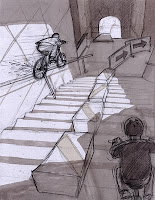Coming from a skate background the first thing I wanted once I started snowboarding was more flexibility on the snowboard. I disliked how the soles of my feet needed to stay stuck parallel to the plane of the snowboard when I was in the air, it felt very restrictive on style. I started designing a solution in 1993. After three years of designing, fabricating and testing prototypes on snow, as well as learning CAD, I submitted a provisional patent in 1996 and a full patent application in 1997. On Jan. 5th, 1999 I received a US Patent #5,855,390 on my concept with claims on around 12 specific designs. Here are two overview pages from the patent:


While learning AutoCAD in school I started drawing with CAD and painting the imagery in Paint shop Pro. Freehand drawing in CAD was called "free didging" and was frowned upon by the design types but my background was in art and I wanted to use the computer to draw as well as design. Here, in autocad, I illustrated how I could ollie higher and do more stylish "shifty's" on my bindings. I also hand rendered over my 3d autocad model with a mouse in paint shop pro. Myself and friends started Skylab designs, the binding was our first product.
Below, In 1996 I drew a sequence of images in AutoCAD for DOS (before Windows), colored them in Paint shop pro and animated in Gif animator. For some reason you have to click the gif to see it animate on the mac.
Testing prototype on Burthod:
The prototype model being ridden above:
Here's my Patent Bunker (under my bed) where I completed patent drawings and new designs:
Here are some early rough design sketches from my notebook.
This is the first sketch and 1st CAD drawing of my 6th design, the 1st one that I prototyped and tested. It worked but I broke a cable after several dozen jumps and decided the design was too complicated. The next day I moved on to to re-designs.
My next prototype was based on a dual torsion spring around a tight fitting lateral pivit axle. It worked great.
Next I designed several potential locking mechanisms in case it was useful to lock the pivoting action in deep powder. The goal was to be able to reach down while riding and lock or unlock the binding. The push button engage shaft design worked best.


In 1997 I started working on a snowboarding video game for Sony and gave it my full attention. The game became CoolBoarders3.
Even though Shorties, Quicksilver, Tony Magnussen of Evol, and other companies had shown interest in the binding product after signing my NDA and seeing my prototypes. Some of these companies wanted me to manufacture it and put their name on it. Heh, I was just a kid with an idea and proven designs and a new baby boy. At the time I was not prepared to setup a manufacturing facility with product liability issues and all that comes with a new product venture of this sort. I was making a Sony Snowboarding game and raising a new family. I was most interested in licensing my designs. I soon became too busy making video games to further manufacture or market my bindings. I just custom made them for myself and a few friends and left it at that.
In a chance meeting that same year I also sat at a table behind closed doors with Tom Sims, Noah Salasnek and Aaaron Vincent. They were all interested in seeing my prototype based on my brief description but Sims would not sign our NDA, Tom Sims asked his lawyer but the lawyer said no he couldn't. I called Joe Herring, my patent attorney/mentor at the time and he told me: Not to show them - we hadn't applied yet - that they could take the design - that there would be plenty of time and opportunities to present it once we had patents applied for and secured on my designs.
I had to walk out of the meeting with my functioning prototypes still in my backpack. That was hard to do but I listened to my mentor. Thinking back maybe I should have just showed them as it may have gotten more traction and gotten to market. After all Aaron Vincent and Noah Salesnek were two of the most skate styled, skate influenced riders at the time. Instead the bindings have only been used underground on only a few elite peoples boards. Marketing them went onto my back burner as I jumped into the fun, simpler, safer and easier route of making video games.
Lately I've been getting a lot of interest in the binding!! and questions from people wanting to ride them! So I am currently back to designing the next model and meeting with potential investors. If I can find the right team to work with we can get them out to a larger market! Stay tuned..!
Contact me if you are interested in working with me on this next evolution of snowboard connectors. Email - PivitBindings@gmail.com


















































